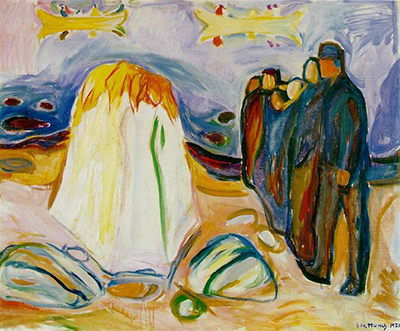Edvard Munch was and is still a celebrated artist. With a combination of technical ability, creativity, and expressionism, he created deeply inspiring artwork.
Meeting, 1921 is one of his impressive oil and canvas paintings. He uses an impressive choice of colour schemes to bring out his art. The image has several colours. The most visible ones are yellow, green, black, blue, and some traces of red. There is a group of people, six visible heads, seemingly staring at a white thing. This thing has a mustard yellow top and a green wrinkle running in a vertical direction. By the sides, there are two huge rocks visible, and they resemble a person's hands. In the middle, there are yellow and green objects. In the far backside of the painting, few birds can be seen suspended on some yellow objects; the seemingly painted birds are colourful. The background of this painting is light purple, blue, and some traces of brown.
In this painting, he uses the artistic expressionism style, using subjective emotions and responses to the events within himself. During this time, Edvard was having a rough time as he was struggling with alcoholism, binge drinking, brawling, and suicidal thoughts. Most people thought that he was on the brink of insanity. With time, he got back up and began taking care of himself. He changed his diet and stabilised his personality. It was during this time that he painted Meeting. Looking back at his childhood, the artist had a harsh childhood where he stayed out of school due to winter illnesses. As such, he had a lot of time to perfect his drawing. His troubled life was a huge contribution to painting and art. He stopped drawing and dabbing with water colours and shifted to painting with oils and canvas in his teenage years.
He drew his painting inspiration from iconic expressionist artists such as Paul Gauguin, Vincent van Gogh and Henri de Toulouse Lautrec. His early paintings drew a lot of negative opinions, and his father reprimanded him severally. His father, however, still provided his living allowance. At one point, he destroyed one of Munch's nude arts. He is remembered for this painting and many others such as Ashes, Madonna, Self-Portrait with Burning Cigarette and Death in the Sickroom. In 2001, he was honoured by having his face on the Norwegian 1000 Kroner front side. On the backside is one of his well-known work, The Sun. He valued his paintings and refused to sell them; he called them his children. This just shows how much he loved painting.




